ATLANTA – A fantasy car deserves a fantasy road, and vice-versa. So we introduced the 2022 Porsche 911 GTS to the Chattahoochee National Forest in Georgia, on some of the fastest, friskiest mountain curves you’ll encounter east of the Mississippi.
Porsche’s family planning adds five GTS variants to the “992” generation of its 911: Coupe and Cabriolet versions of the rear-drive Carrera and all-wheel-drive Carrera 4, plus the AWD-only Targa 4. These models bring all manner of gifts for 911 fans, but without going full-bonkers for a Turbo, GT3 or other top-shelf edition.
We drove the leather-lined bookends of the GTS family, a pair of German-spec models that Porsche shipped to its Atlanta HQ for reviewing: The rear-wheel-drive Carrera GTS is the purist’s special, the lightest and most affordable version at $138,050 to start. To underline its target audience, our Carmine Red edition was equipped with the brilliant, no-cost-option seven-speed manual transmission, its lever shortened by 0.4 inches in GTS trim. Following a mountain workout, I made a return run in a Targa 4 GTS (from $158,150). The retro-inspired, open-air Targa is the fashion plate of 911s, newly rippling in GTS guise, with standard AWD, an eight-speed PDK automated gearbox and a torque-vectoring electronic rear differential. This particular one’s gray-white “Chalk” paint proved an ideal canvas for the black body detailing that marks every GTS.
You will surely hear these GTS models described as the sweet spot of the 911 lineup, and they are – if the prices don’t trigger a diabetic coma. The GTS variants demand a $20,000 to $21,000 upcharge from respective 911 S versions. Yet in Porsche’s configurating defense, optioning up any 911 to approximate GTS spec would cost vastly more than $20,000. GTS models also bring features unavailable on standard versions.
First, each GTS gets 30 extra horsepower and 23 pound-feet from its twin-turbocharged, 3.0-liter flat-six (versus S models), for 473 horsepower and 420 pound-feet. That gain comes exclusively from dialing the high-compression engine’s turbo boost to 18.6 psi, a nearly 15% gain. The dual-mass flywheel is reinforced to handle the added power and torque. How fast, you ask? Porsche conservatively cites the Carrera 4 GTS’ 0-60 mph dash at a blistering 3.1 seconds, with an also-conservative 11.5-second quarter-mile, aided by PDK and launch control. A stick-shift Carrera 4 GTS is a notable 0.8-seconds slower to 60 mph, at 3.9 seconds. The Targa 4 S comes in at 3.3 seconds, which turns out to be good enough to shoot the sunglasses off my forehead and into the back seat.
More power is only the beginning. The PASM sport suspension is standard (which adds a Sport stability mode), as is a selectable Sport Exhaust with a killer soundtrack. The Sport Chrono package is onboard, with launch control and a Sport Response steering-wheel button for PDK versions. Additional Sport Chrono goodies include active driveline mounts, analog and digital dashboard chronographs, and additional Sport Plus and Individual driving modes. Next come inheritances from Daddy Warbucks, the 911 Turbo: All GTS bodies are lowered by 0.4 inches, with added rear-axle helper springs for Coupes and Cabriolets. The Turbo’s brakes serve up pizza-sized 16.0-inch front rotors, with carbon-ceramic brakes and even-roomier rotors available for $9,780. Staggered, 20- and 21-inch Turbo S Design forged alloy wheels bring a standard Satin Black finish and center locking hubs, though there’s an optional five-lug wheel for buyers who prefer easier changes, including for flats on the side of the road. Key performance options include the active rollbars of Porsche Dynamic Chassis Control, rear-axle steering, and a useful GPS-linked front-axle lift system that clears low-speed obstacles and remembers where they are.

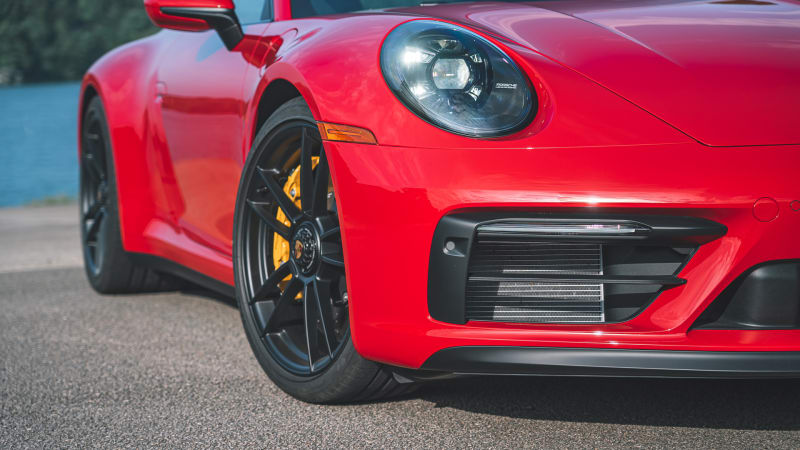
As with any 911 variant, there are subtle exterior changes: revised front and rear fascias, black-finished exhaust outlets, more black for the rear engine-lid slats and Porsche decklid script, and smoky tint for headlamps and a dramatic, full-length taillight strip. Inside, Race Tex faux suede replaces leather for the steering wheel, manual shift lever, seat centers, armrests and console, with brushed aluminum black trim. Interior packages (for $4,530), in either Carmine Red or Chalk, bring matching stitching and tachometer colors. Oh, and the Targa GTS gets a black Targa bar.
All 2022 911s get the PCM 6.0 touchscreen infotainment system, a reskinned version of the unit in the electric Taycan. It’s a many-layered upgrade from previous Porsche units, but I’m still mildly bedeviled by Porsche’s stubborn reliance on miniature hieroglyphs for various functions. And the outer orbs of the 911’s five ringed driver gauges are almost entirely eclipsed by the steering wheel, forcing drivers to crane necks to see fuel levels and other data.
A first-ever GTS Lightweight Package, which we sampled on the Carrera Coupe, trims 55 pounds by eliminating rear jump seats and floor mats, stripping out sound deadening, and adopting a lightened battery and glass. It also gets rear-axle steering, a steeper maximum tilt for the rear spoiler, and an aero-optimized underbody. Four-way sport seats are standard, but buyers might aim for optional 14- or 18-way powered seats, which strike a smart balance between a luxurious perch and robust performance. Our GTS Coupe featured full carbon-shell bucket seats (for $5,900) with only a manual fore-aft slider and no seatback tilt adjustment. We’ve now sampled these in variety of Porsches, including most recently in the GT3 Touring, and our general conclusion is that they’re a track rat’s dream and reasonably comfortable over long distances, but if your likely driving will involve more of the latter, get one of the other seat upgrades instead. Your body will thank you. So too will you wallet: even our Targa’s stellar 18-way seats cost $3,030, saving nearly three grand versus the carbon buckets.
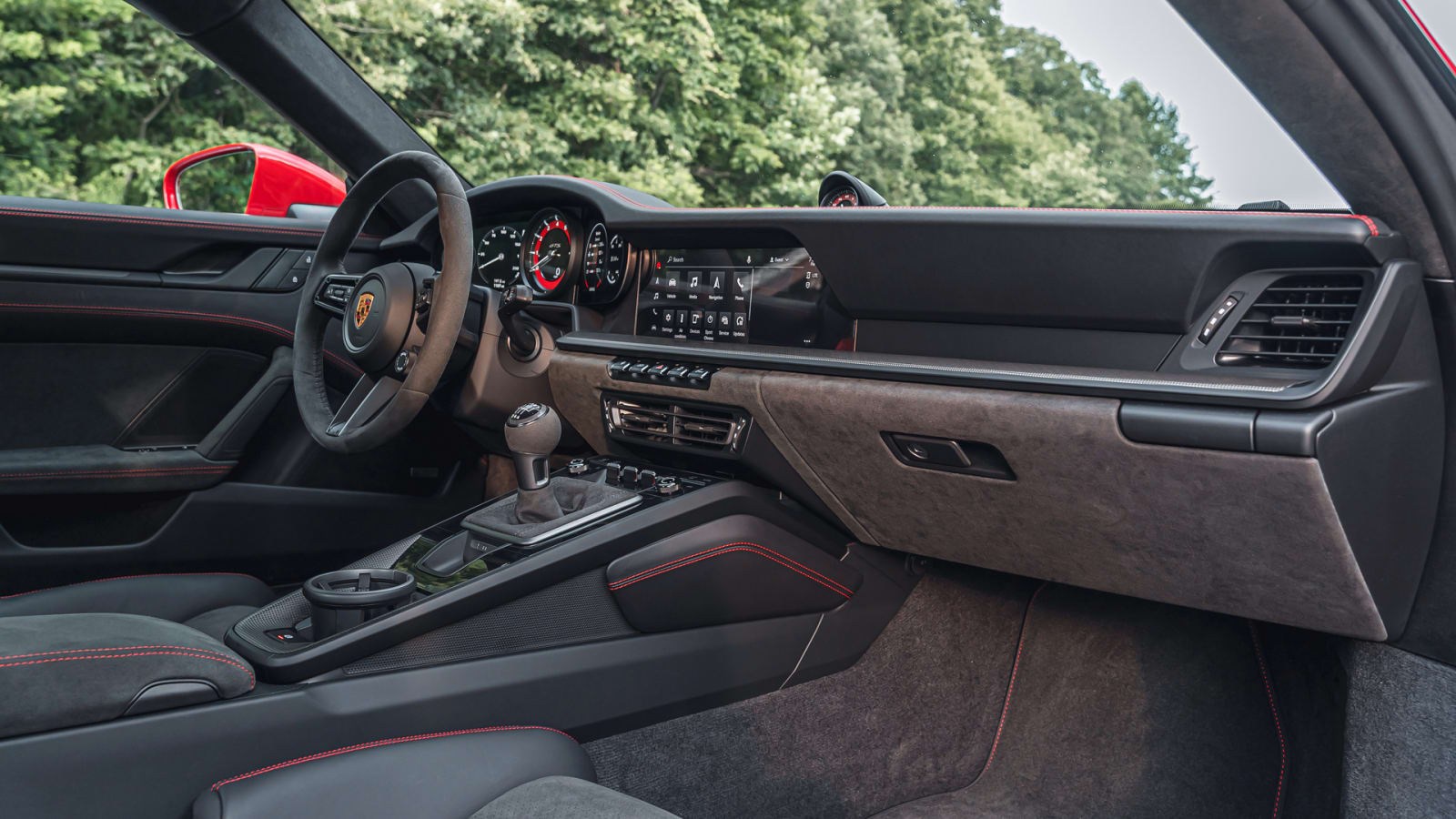
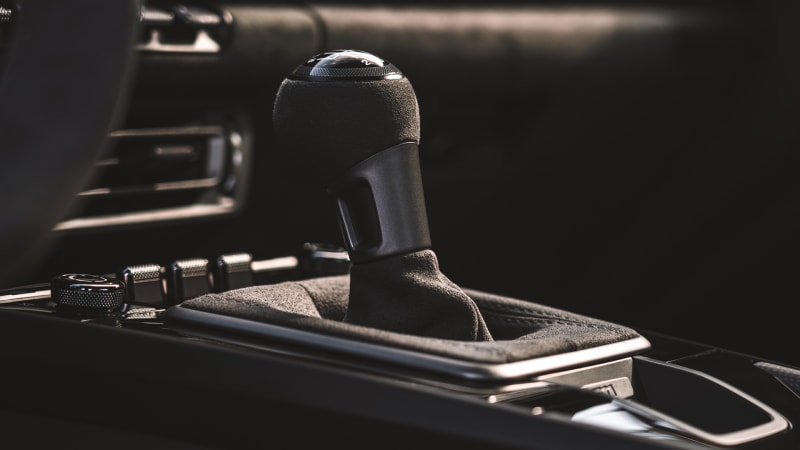
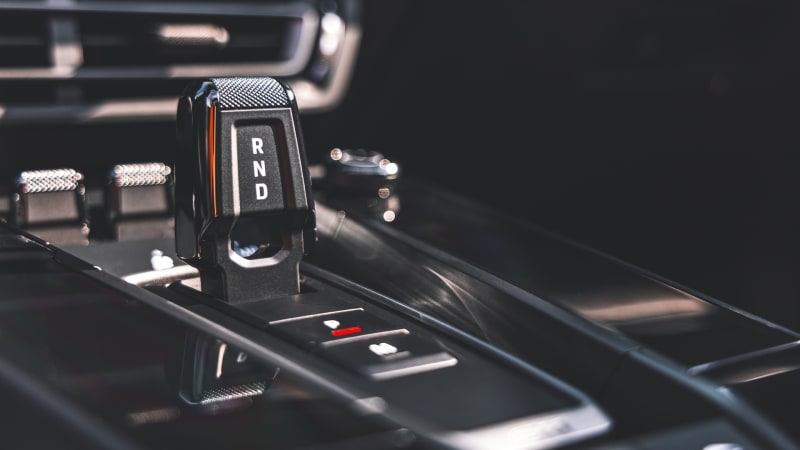
The most impressive option, though, is one you don’t have to pay for. The seven-speed stick shift’s totalizing effect on the Carrera Coupe’s performance and tech is nothing short of amazing. With its golf-ball-shaped shift knob, bang-bang short throws, and creamy clutch take-up, this has to the best surviving manual on the planet. In a welcome change, the manual’s rev matching feature – “Auto Blip” in Porsche parlance – can now be disabled without shutting off stability control (something that was previously possible in the GT3, GT4 and 718 Spyder). That’s common sense for drivers who might well want to practice heel-and-toeing on public roads, without losing the safety net of stability oversight.
Here in the North Georgia mountains, the picturesque roads feature two-lane, multi-mile passing sections in one or the other direction, with a smorgasbord of Insta-worthy ascents, descents, hairpins, esses and sweepers. With two lanes to play with, there’s more safety margin. Drivers are free to whomp a car into bucket-like cambered apexes from the far lane, using suspension compression to go even faster; then track out wide to the outside lane stripe. It’s like having a personal double-wide raceway, with the key ability to safely pass slowpokes or lumbering trucks at will.
This forested gantlet revealed key differences between Coupe and Targa, rear- and AWD versions. First: Porsche’s AWD sports cars, as with many modern peers, are almost unfairly fast and tenacious. For the four-wheeling Targa 4 GTS, the technique is to brake deep into corners, get back on throttle even before some apexes and then marvel at how the Porsche can tighten its line or dig its way out. There’s just no disputing the advantage of two extra “rowers” pulling up front. Despite its lighter weight and slightly tauter suspension, the rear-drive GTS Coupe couldn’t match the sheer grip and early-to-throttle ease of the Targa.
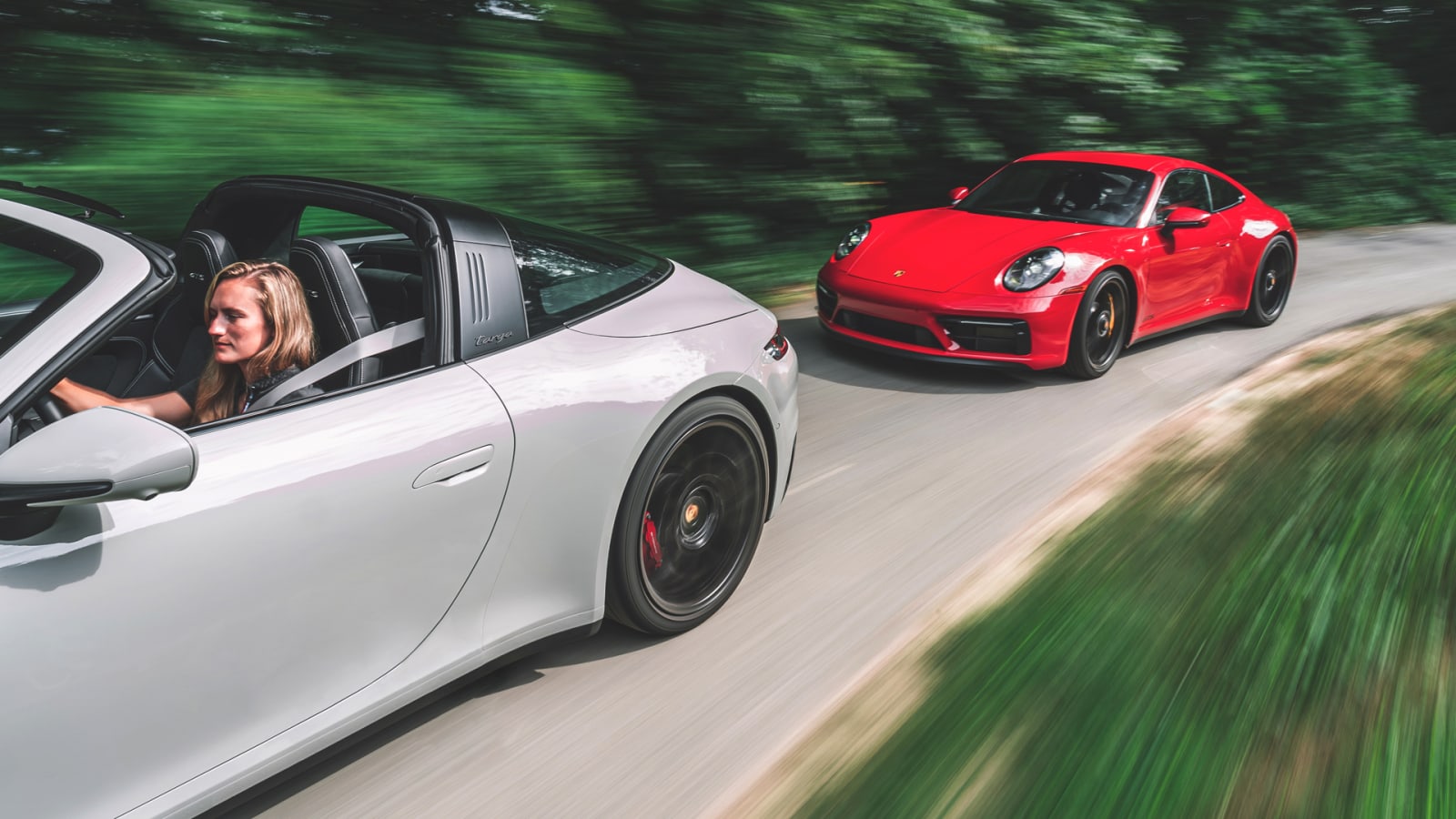
And yet: As much as I adore the Targa’s sexier body style, the GTS Coupe is even better, and costs $20,000 less. The Coupe is more alive, precise and fun-to-drive, especially for pilots prepared to handle a rear-driven Porsche’s edgier nature. The coupe feels lighter and tighter, its steering even more uncannily responsive. I found myself wishing that every enthusiast, especially those who scoff at or are unfamiliar with Porsches, could experience what this GTS is about: It’s simply one of the world’s greatest performance experiences, regardless of price.
Urged on by the 911’s enabling personality, I found myself squealing the Coupe’s tires through long curves, the flat-six spinning silk to a 7,200-rpm peak. Surprisingly, the GTS Coupe actually sounded better than the open-air Targa. Both models pump sound into the cabin via a symposer-type device. But the Coupe admitted more chesty, low-frequency sound – including the 911’s heroic, near-GT3-harmonics when the tach passes 6,000 rpm – than the Targa’s whispery induction and turbo whistle. This particular Coupe’s rear-seat delete and Lightweight Package additions/subtractions may have had something to do with that.
Of course, no Porsche review would be complete without mentioning the damage it will inevitably do to your bank account, especially after checking boxes on the extensive options list. As mentioned earlier, the Carrera GTS Coupe’s starting point of $138,050 isn’t that outrageous given what you’d pay to get a regular Carrera up to similar speed and specification using that options list. Still, our GTS Coupe checked out at an as-tested $178,440. The Targa 4 GTS hit $193,960, a number that used to be associated with Turbos or GT2’s. Owners could certainly skip some optional frou-frou. (A 23.7-gallon extended-range fuel tank is a rare brand bargain at $230). But as Porsche spokesman Luke Vandezande notes, most owners aren’t worried about breaking the bank: 911 customers enjoy a cushy, median household income of $550,000, and $450,000 for all Porsche-brand buyers.
And for serious enthusiasts, the GTS models deliver as advertised: This is the middle ground between the everyday versatility and comfort of a “basic” 911, and the otherworldly (and even pricier) performance of a Turbo or GT3. Hell, if I could afford one, I’d already be speccing my own GTS Coupe, and consoling myself that at least the stick shift is free.
Related video:
